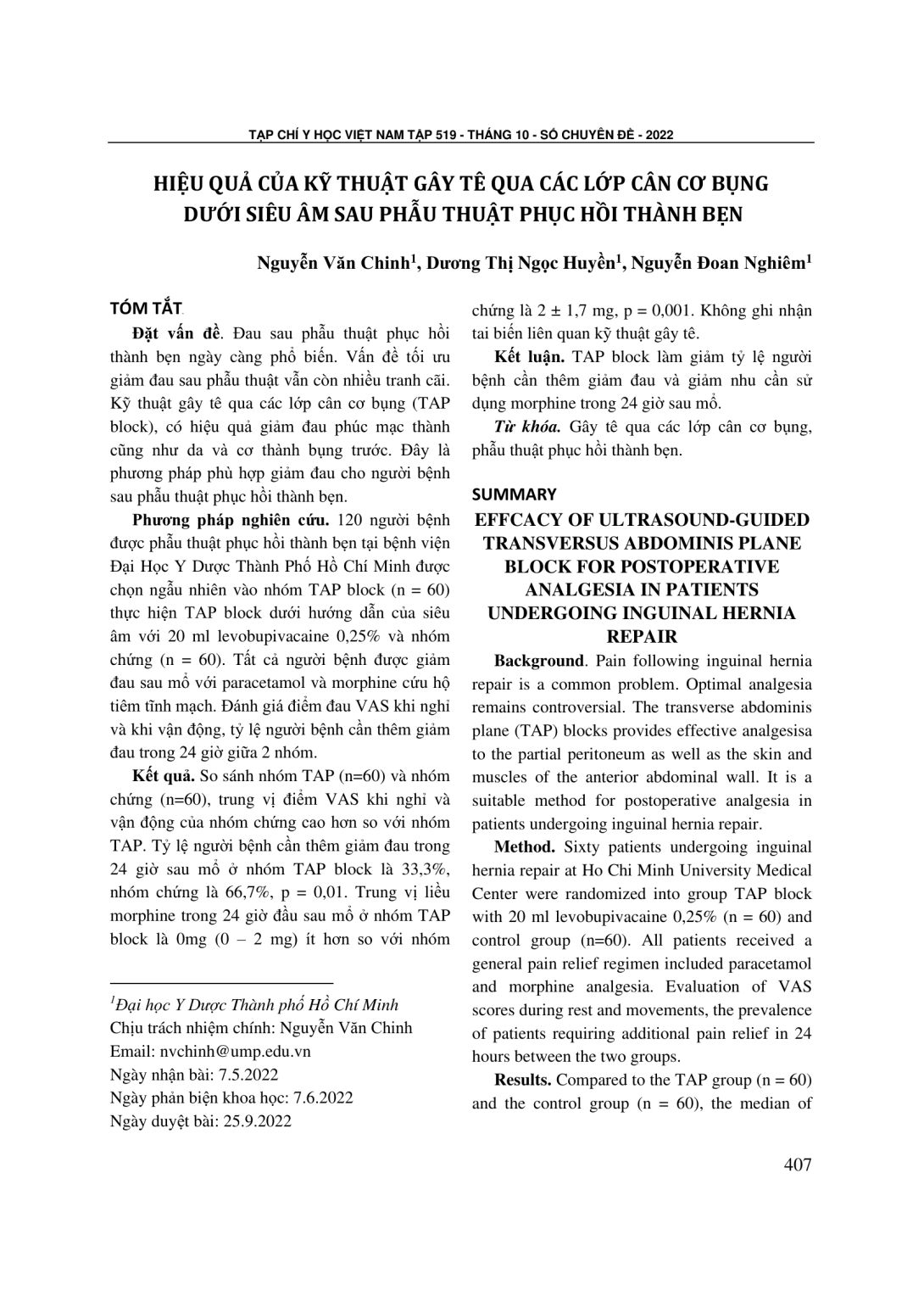
Đau sau phẫu thuật phục hồi thành bẹn ngày càng phổ biến. Vấn đề tối ưu giảm đau sau phẫu thuật vẫn còn nhiều tranh cãi. Kỹ thuật gây tê qua các lớp cân cơ bụng (TAP block), có hiệu quả giảm đau phúc mạc thành cũng như da và cơ thành bụng trước. Đây là phương pháp phù hợp giảm đau cho người bệnh sau phẫu thuật phục hồi thành bẹn. Phương pháp nghiên cứu. 120 người bệnh được phẫu thuật phục hồi thành bẹn tại bệnh viện Đại Học Y Dược Thành Phố Hồ Chí Minh được chọn ngẫu nhiên vào nhóm TAP block (n = 60) thực hiện TAP block dưới hướng dẫn của siêu âm với 20 ml levobupivacaine 0,25% và nhóm chứng (n = 60). Tất cả người bệnh được giảm đau sau mổ với paracetamol và morphine cứu hộ tiêm tĩnh mạch. Đánh giá điểm đau VAS khi nghỉ và khi vận động, tỷ lệ người bệnh cần thêm giảm đau trong 24 giờ giữa 2 nhóm. Kết quả. So sánh nhóm TAP (n=60) và nhóm chứng (n=60), trung vị điểm VAS khi nghỉ và vận động của nhóm chứng cao hơn so với nhóm TAP. Tỷ lệ người bệnh cần thêm giảm đau trong 24 giờ sau mổ ở nhóm TAP block là 33,3%, nhóm chứng là 66,7%, p = 0,01. Trung vị liều morphine trong 24 giờ đầu sau mổ ở nhóm TAP block là 0mg (0 – 2 mg) ít hơn so với nhóm chứng là 2 ± 1,7 mg, p = 0,001. Không ghi nhận tai biến liên quan kỹ thuật gây tê. Kết luận. TAP block làm giảm tỷ lệ người bệnh cần thêm giảm đau và giảm nhu cần sử dụng morphine trong 24 giờ sau mổ.
Pain following inguinal hernia repair is a common problem. Optimal analgesia remains controversial. The transverse abdominis plane (TAP) blocks provides effective analgesisa to the partial peritoneum as well as the skin and muscles of the anterior abdominal wall. It is a suitable method for postoperative analgesia in patients undergoing inguinal hernia repair. Method. Sixty patients undergoing inguinal hernia repair at Ho Chi Minh University Medical Center were randomized into group TAP block with 20 ml levobupivacaine 0,25% (n = 60) and control group (n=60). All patients received a general pain relief regimen included paracetamol and morphine analgesia. Evaluation of VAS scores during rest and movements, the prevalence of patients requiring additional pain relief in 24 hours between the two groups. Results. Compared to the TAP group (n = 60) and the control group (n = 60), the median of VAS scores during rest and movements were higher in the control group than in the TAP group. The prevalence of patients requiring analgesia in the 24 hours postoperatively in the TAP block group was 33.3%, the control group was 66.7% (p = 0,01). Median morphine level in the first 24 hours postoperatively in the TAP block group was 0 mg (0 - 2mg) less than the control group 2 ± 1.7mg, (p = 0,001). There were no complications related to anesthesia. Conclusion. TAP block reduces the rate of patients requiring additional analgesia and reduces the need for morphine for 24 hours postoperatively.
- Đăng nhập để gửi ý kiến
